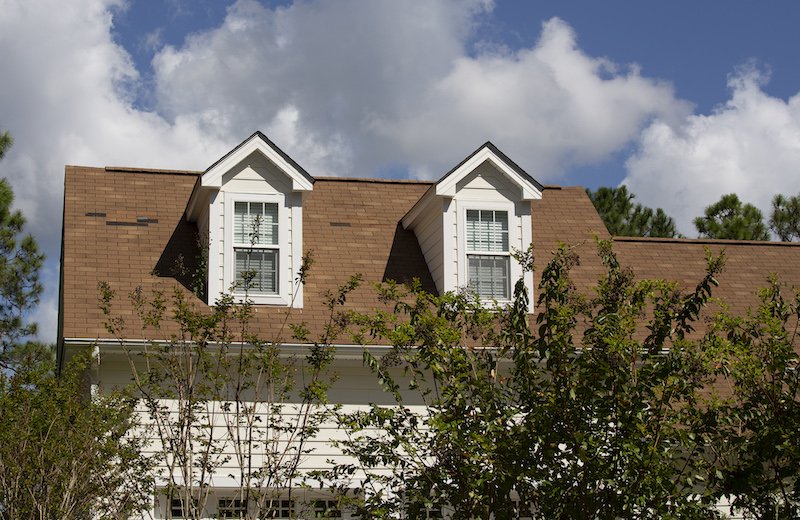
A leaking roof is rarely a temporary issue, by the time you see a water spot on your ceiling. Usually, it’s an indication that water had found a way through the roof covering, through the plywood decking, and possibly saturated insulation, dripped enough onto the drywall to soak through, and finally discolor the cardboard through the paint. It’s important to get this problem resolved as soon as possible. Otherwise, wood starts to swell, rot, drywall deteriorates, mold and mildew can start to grow, and what might have been a simple patch or caulking can become major restoration.
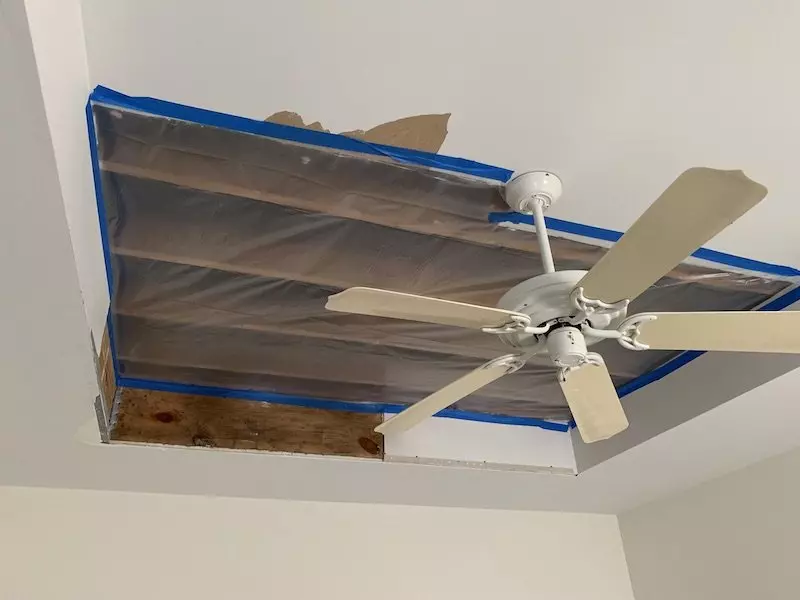
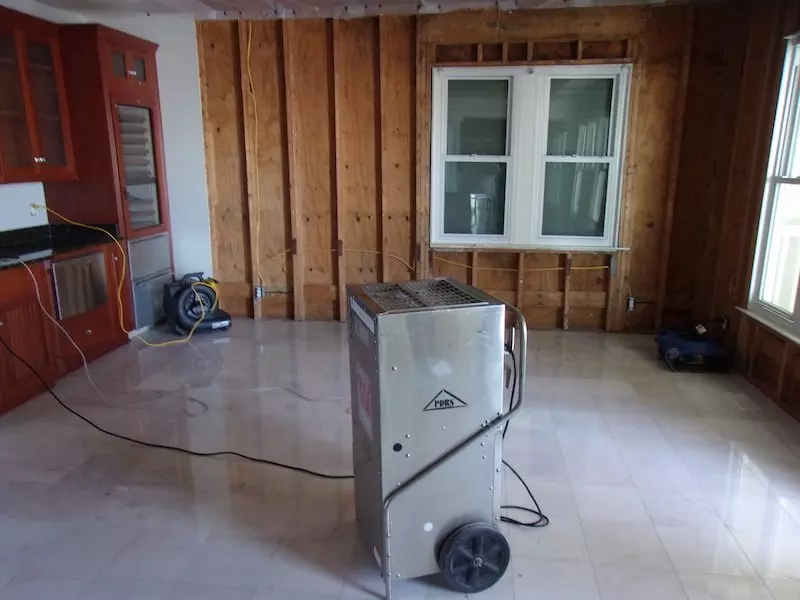
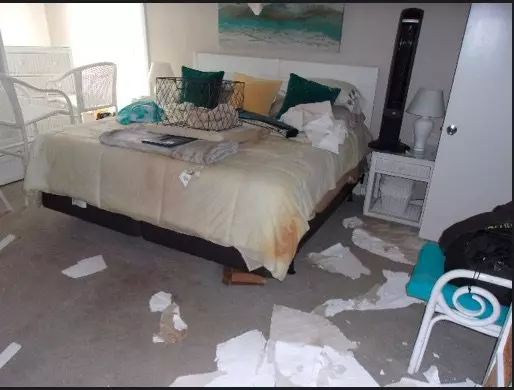
Cook Roofing Company has plenty of experience tracing and finding roof leaks. We can determine whether the leak is from something simple, how easy it will be to repair the leak, and whether storm damage might have caused the leak. If it was a storm, your insurance may provide coverage. Depending on the extent of the damage, you might be owed a new roof. Wouldn’t you rather put your money towards the deductible on a new roof, than spend it on a patch? Contact us today for a free roof evaluation and estimate. We’ll help you understand the extent of the damage, and how best to proceed. We offer an Apples to Apples price match guarantee and a lifetime workmanship warranty on our new roofs. We can also meet your adjuster and help you understand the insurance claim process, if you have storm damage.
Contact your trusted local roofing company in Springfield, MO and Branson today, using the form on the right, or call us at 417-334-4238.
Here’s some more information about roof leaks.
How Roof Leaks Affect Your Home
Roof leaks can emerge for a number of reasons. One homeowner had a squirrel who developed a taste for the pipe jack flashing on his roof. That was a pretty simple fix, though he needed a fair bit of sealant and painting inside.
Caulking or Asphalt Deterioration
A common source of leaks is caulking or rubber components that start to let water in. Any time asphalt or rubber is exposed to UV light from the sun, it starts to fade and deteriorate. Then it can start cracking, and let water through. Metal roof fasteners have rubber grommets that can eventually deteriorate and leak. In one photo below, you can see black spots where the owner tried to seal the exposed fasteners. Note that this metal roof had already been coated with silicone. And it was still leaking. We did not do any of the work shown in any of these photos, by the way.
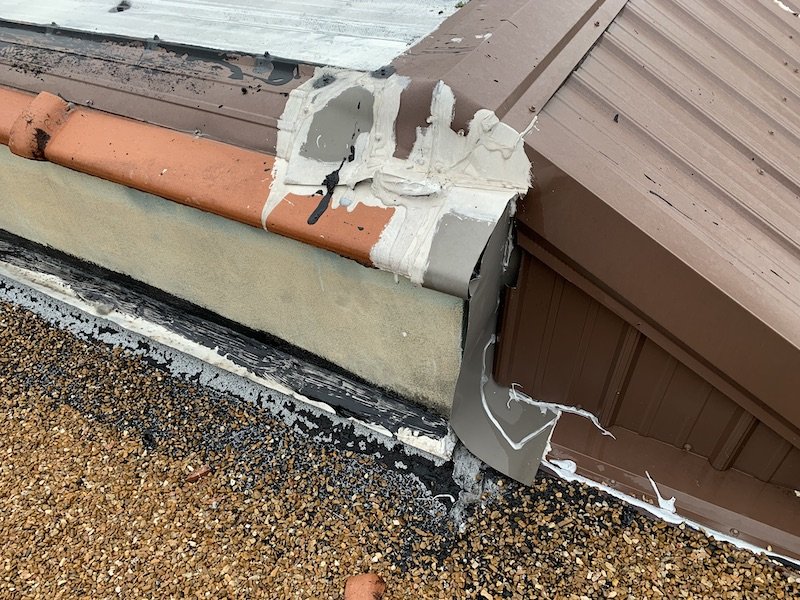
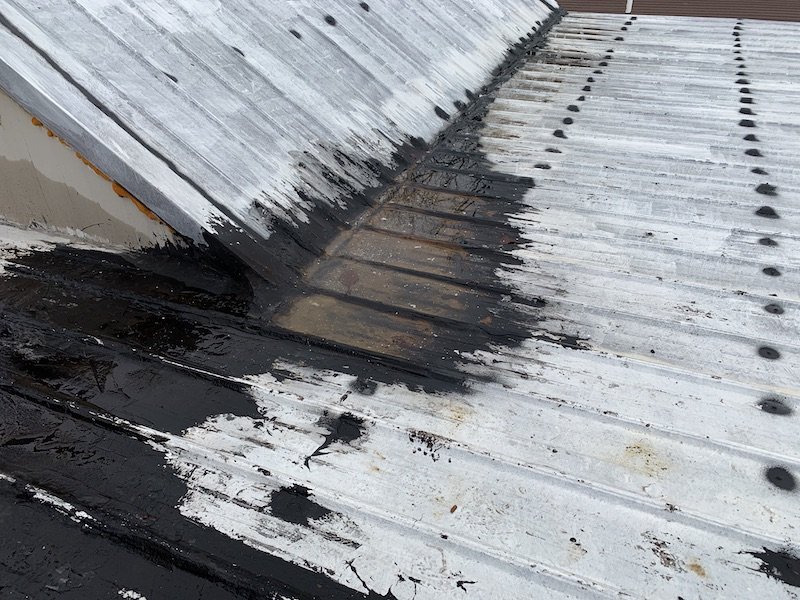
UV protection is the reason that asphalt shingles are covered with granules. Those little rocks are not just for decoration – they hide the asphalt in the shingles from the sun. Over time, the granules come off from rain, foot traffic, really anything that touches them.
As a roof gets older, the asphalt they are embedded in doesn’t hold them as well and they will come off easily. The sun gets through to the shingle base, deteriorates it more, the shingles get brittle… this is why shingle roofs eventually need to be replaced in 12-20 years.
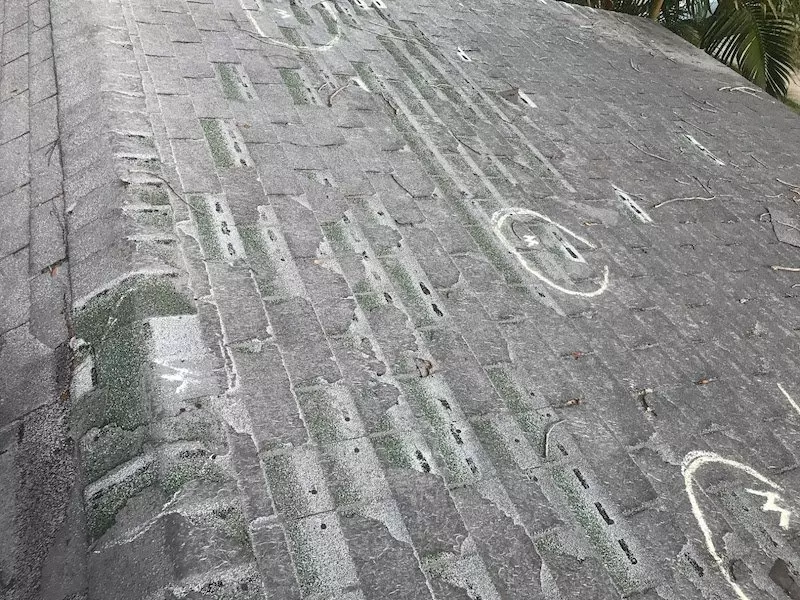
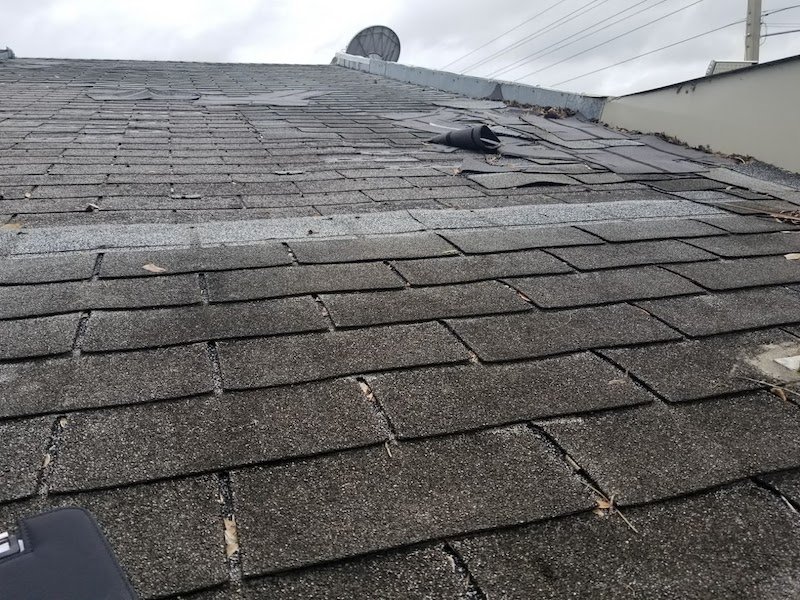
Heat Damage From Improper Ventilation
Sometimes this deterioration happens much more quickly, though. A roof without proper ventilation allows the shingles to overheat. If the roof is overheated, and cools suddenly from rain, it causes even more stress on the roof. In the Springfield, MO area, the sudden thunderstorms do this a lot. Over time, this can prematurely age the roof. That’s why a “30 year shingle” might only last 10-12 years.
Hail Damage
Another big reason that shingles have a shorter life in Missouri is the frequent hailstorms. Almost every house in Springfield MO and Branson has been hit by hail at least once in the past several years (if not 5-10 times). We can pull up a storm report on your address for free, by the way. Hail can bruise the shingles, and knock granules off, especially in the bruised areas. Just because you can’t see the damage from the ground doesn’t mean we can’t spot it. It’s tough to see, and even some adjusters miss it (whether that’s genuine or on purpose, is another story). Hail damage generally indicates a new roof is needed though, because the damage is across the entire roof surface (or enough that repair doesn’t make sense).
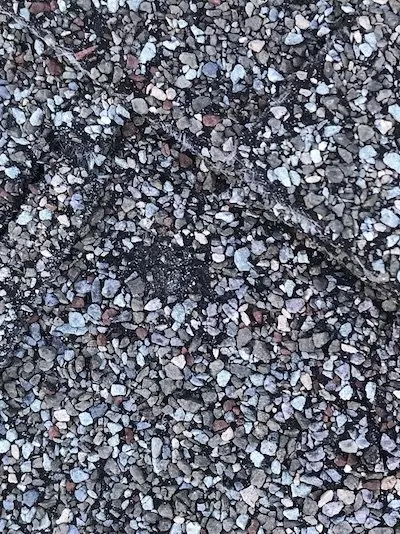
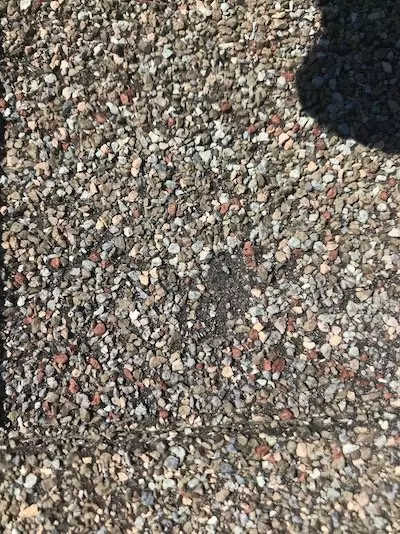
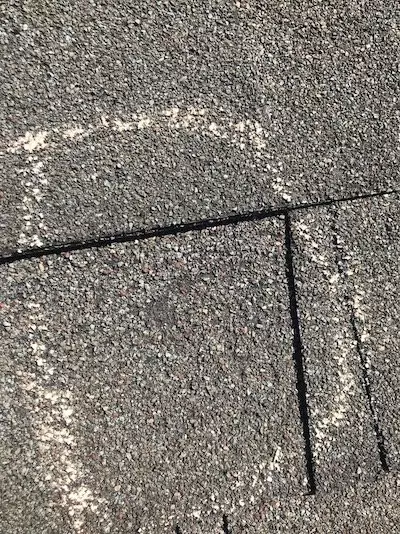
Winds From Thunderstorm
Thunderstorms often come with wind, and we’re not even talking about tornadoes! The same wind that lifts 2 inch hailstones miles into the air, can cause wind gusts. It has to do with the warm moist air from the ground rising, cooling, and then the rain causing it to cool even more, that air rushes down and out, sometimes in “straight line winds.’ (If you’re interested in how this happens, there’s a better discussion here, and here. And even more detail about the science behind thunderstorm formation and wind shear here.)
Regardless of why thunderstorms cause wind damage, though, is the fact that wind can cause roof damage. The biggest leaks are usually caused by wind. Your roof may have been susceptible to wind damage because of the sun, heat, age, etc. This is a good reason for preventative maintenance, by the way – which Cook Roofing Co offers. But if your old roof is damaged by wind, it is still almost always covered, if you have wind damage coverage. (most policies do. We can’t advise on yours specifically, as your roofing contractor. We can just say that in general, an old roof that’s covered by a policy against damage caused by an event – peril – covered by that policy, is still covered, even if it was barely holding on.)
Some of the damage that wind causes is obvious, and some is harder to spot. Here are a few different types below.
Missing Shingle Tabs
This is the easiest type of wind damage to spot. If wind separates the tabs from the mastic strip underneath (the heat-activated adhesive strip that glues the overlapping tabs to the shingle below), then wind can fold those tabs back, and rip them off. The thicker, newer, and more flexible the shingle, the less likely this is to happen. New shingles will fold back and return to their shape without much damage (though there may be creasing).
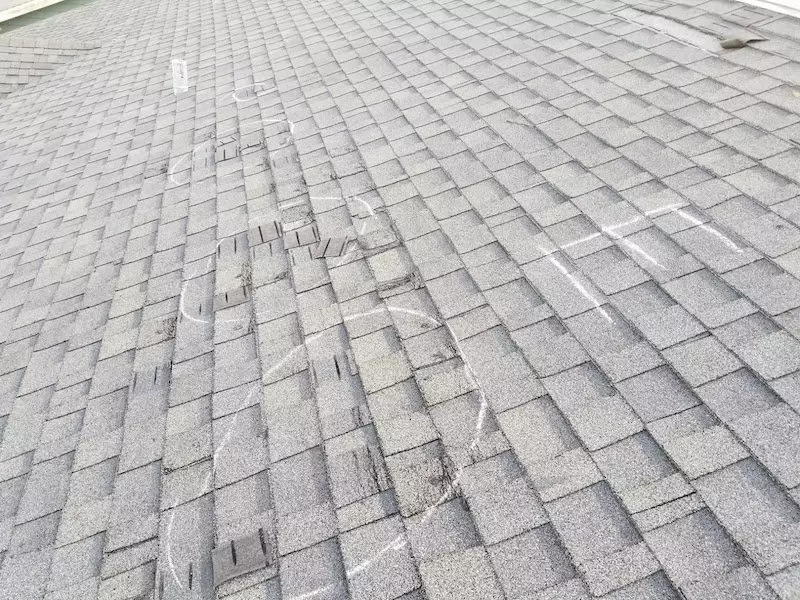
Missing Shingles
Other times, shingles get completely pulled out from under other shingles, or ridge cap shingles get blown off. While missing tabs look bad, and can allow water underneath shingles, completely missing shingles almost always let water through. Plywood and felt underlayment with nails through it is not waterproof. It helps to shed water, more than if there was nothing… but if there’s no shingle over it, the roof is almost always leaking there.
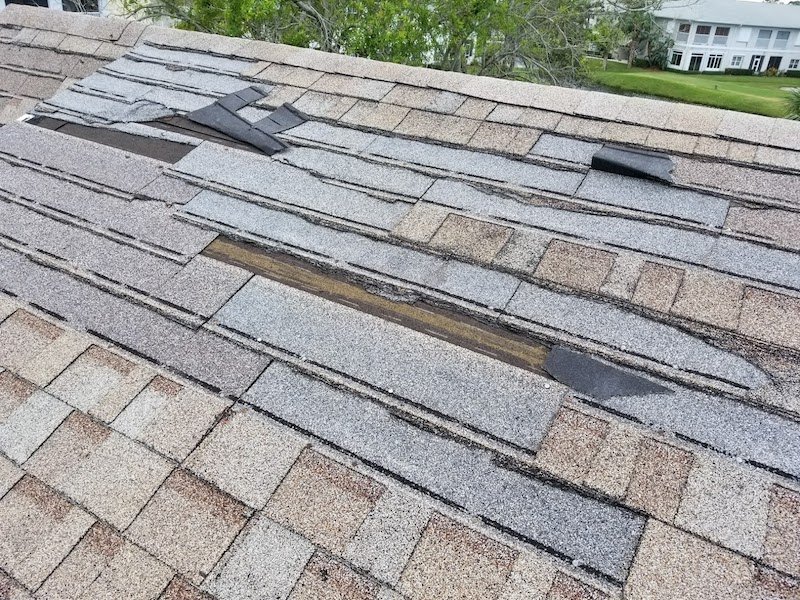
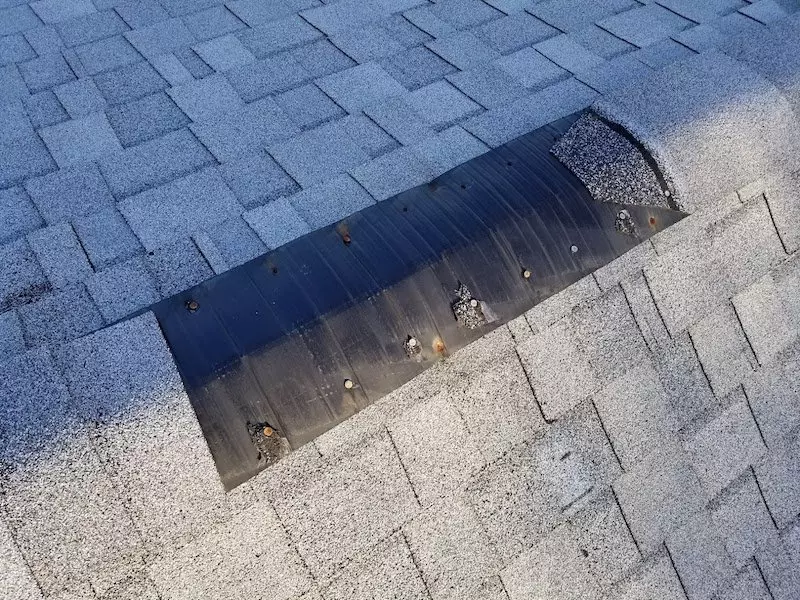
Lifted Shingle Tabs
This is less obvious, and sometimes insurance companies don’t want to cover this damage. It’s true that if shingles lift, and then lay back down, they will usually seal again when the sun warms the roof up again. The exception here, though, is if there is debris and dirt stuck to the mastic strip, or if the mastic tore off some of the shingle material so that there is no sticky adhesive available. This is more common during hurricanes, because of the sustained high winds blowing debris under the shingles, but it can happen with thunderstorms, too. We’ve seen “lifted shingles” denied by insurance as a reason to buy the roof. Other times, the adjuster agreed that lifted shingles with debris stuck to the mastic strips was a valid reason to approve roof replacement.
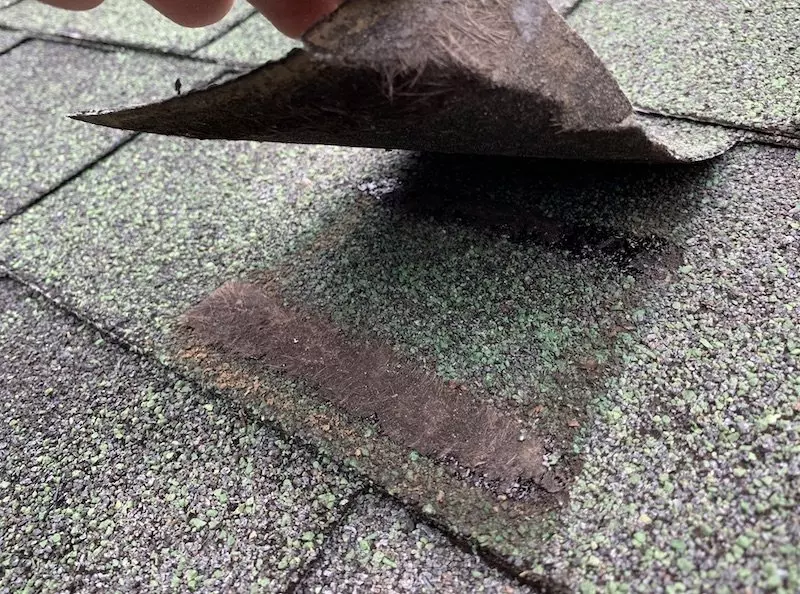
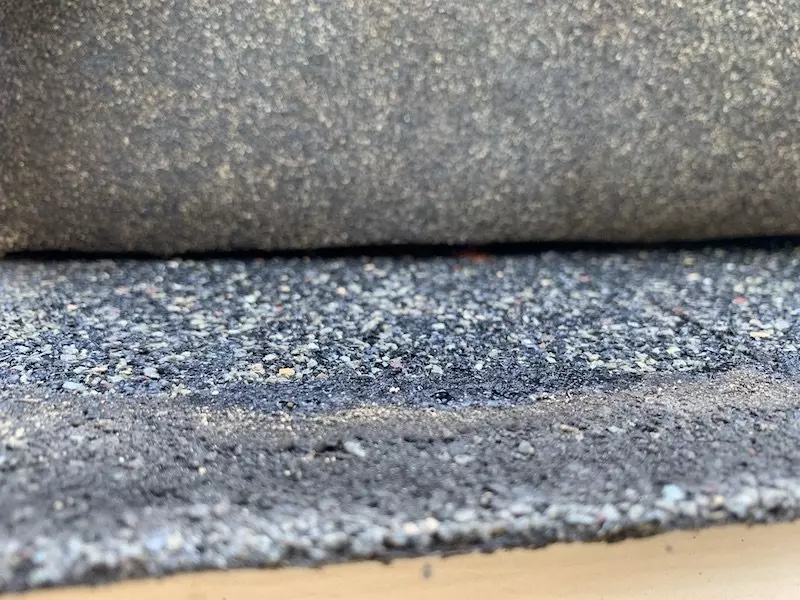
![Roof Leak Repair 17 [iss_alt_text_page_title_city_state_abbr]](https://www.cookroofingbranson.com/wp-content/uploads/2020/01/shingle-inspection.jpg)
Damaged Flashing
Flashing on a roof protects areas where two surfaces come together. This might be a chimney, end wall, valley, or vent pipe. The flashing helps keep water out of the junction. Sometimes this flashing blows loose, and this allows separation that allows water underneath. This is the number one cause of roof leaks. Sometimes the damage is obvious. Other times, you have to get on the roof and look closely, checking to see if it’s loose. If you don’t feel comfortable getting up on your roof, we’d be happy to come out and check it for you. We know exactly what to look for. If you really just like heights, you’re welcome to come up on the roof with us!
Fascia and Soffit Damage
Fascia is the trim that runs along the edge of the roof. Usually made of 1″ x 6″ or 1″ x 8″ wood, sometimes it’s wrapped in aluminum or vinyl. If this is pulled away from the roof, it can let water in. Another thing it can let in is wildlife. Houses are not very good homes for squirrels, birds, mice, raccoons, wasps, hornets, and whatever other things might think they’d like to live in your attic. Fascia helps keep these guys out.
Soffits
Most roofs have an overhang along the eaves (flat edges of the roof) and rakes (the sloped edges of the roof). If the eaves are closed, like most are, it forms a “soffit box,” and the underside of this is referred to as the soffit. Soffits can be hardboard, plywood, metal, or vinyl. The metal and vinyl types slide into a channel strip, and they are usually also nailed or screwed into the soffit framing.
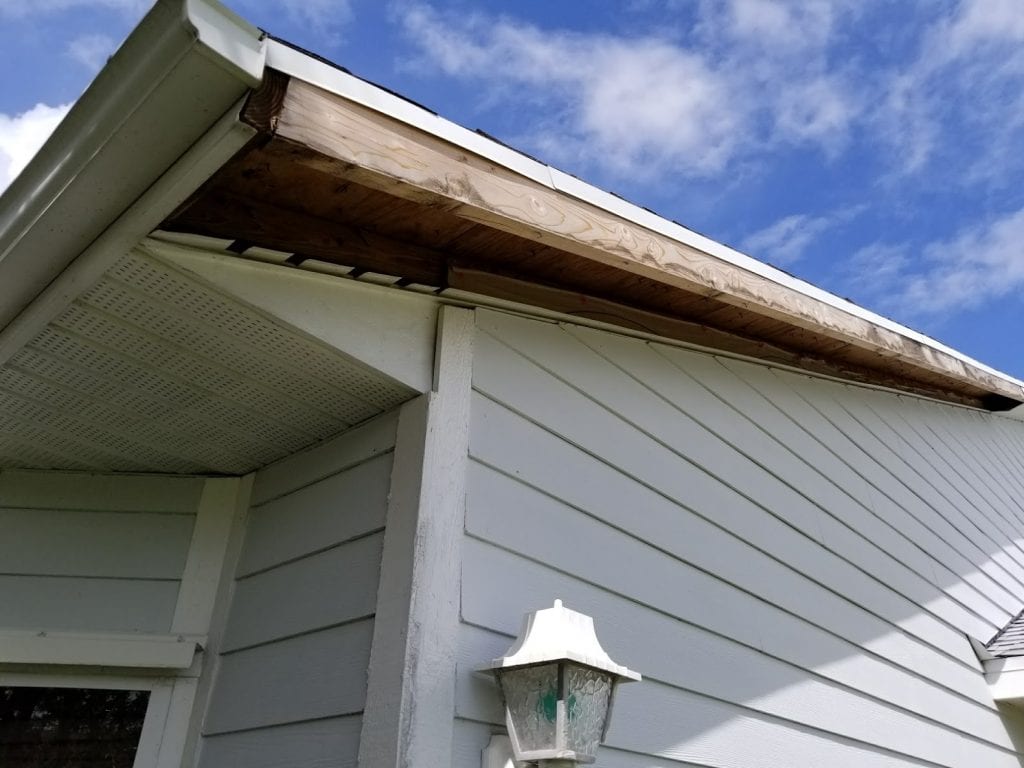
When wind blows soffit panels loose, it often rips the screws through the panel, so it has to be replaced. And soffit should really be slid from one end to another, not just bent to squeeze it back in. This means removing other panels and then replacing them, too. We’ll make sure an insurance adjuster knows this, and doesn’t just suggest that you need one piece of soffit panel worth $12. Sometimes they do that. It makes us want to ask them to be generous and kick in another $2.99 for a packet of screws!
You might wonder how missing soffits can cause leaks, since they are under the eaves of the house. Well, it’s usually from blowing rain up underneath. This is one of the only temporary ways a roof can leak sometimes but not during other rain. We see this more with hurricanes, where hours of rain drove enough water through the soffits to soak the attic, collapse ceilings, etc. Your biggest concern with missing soffit, though, is pests, just like with missing fascia. You might like hearing squirrels chew on things and play Camptown Races at 2am in your attic, but they might also chew through wires, and cause a fire. Let’s get that fixed, before one squirrel becomes a family of squirrels.
Tree Damage
This source of a roof leak is fairly obvious most of the time. A tree falls on your house, or maybe just a branch. It’s going to cause your roof to leak. But sometimes a branch might hit your roof and bounce/slide/roll off. The damage is done, but not as obvious. If you weren’t home to hear it, you might not know about it. (You can debate whether it made a noise, if no one was there to hear it. But it almost certain caused damage.)
Branches are considered falling objects, and are often covered. Don’t just go put some caulk over the hole! Depending on how big the branch was, there may be damage you can’t see. Insurance adjusters won’t usually look too hard for that, their job is to save the insurance company money. Our job, however, is to handle your home as though it was our own, and make sure we repair things the right way. We’ll give you a fair and thorough estimate for the repair, and be able to back it up and explain it to the adjuster if needed.
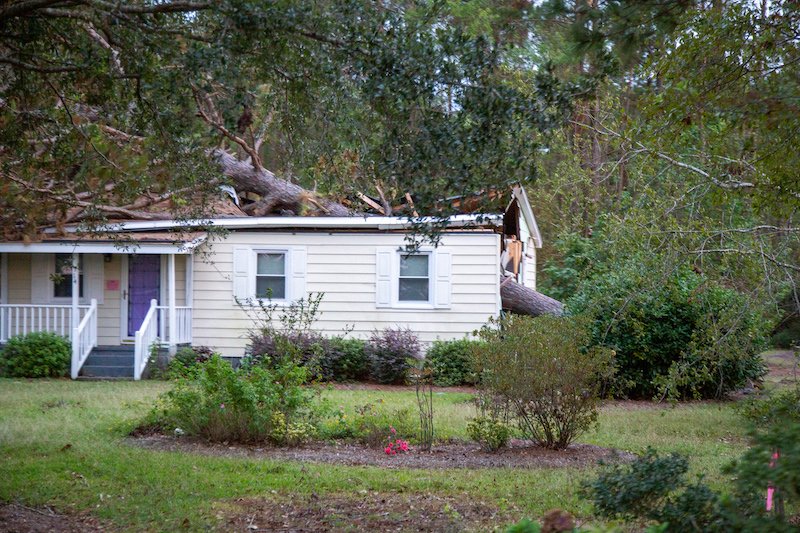
Collateral Damage
Like we mentioned before, a leaking roof might only show itself as a spot on your ceiling. Sometimes, though, the hidden damage can be extensive, especially if it’s allowed to leak for a long time. Many leak repairs need more than some spot sealer – those stains can bleed back through the new paint.
Drywall Damage
If the drywall has gotten very wet at all, the gypsum can swell and crumble. Normal interior drywall is not made to get wet at all, ever. And if that water came from a storm, it’s considered “Category 3” water (contaminated water) because it may have blown up from the ground. Cat 3 water damaged drywall is supposed to be replaced for health reasons. Adjusters sometimes say “oh, you can just put a spot sealer (like Kilz) on it, and then a coat of paint.”
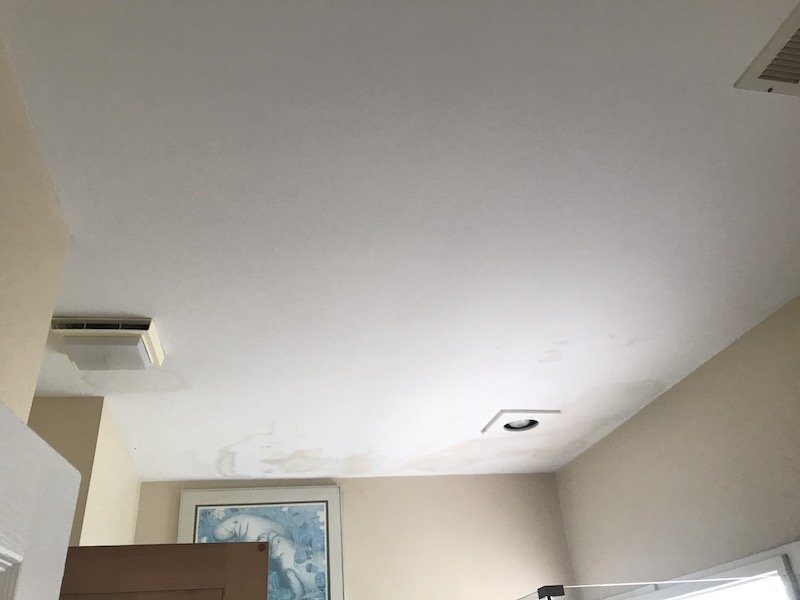
By the way, this Category 3 water is not a made up thing. The Institute of Inspection, Cleaning, and Restoration Certification (IICRC) describes in their document, S500 Standard for Professional Water Damage Restoration, Category 3 water:
Category 3 water—Is grossly contaminated and can contain pathogenic, toxigenic, or other harmful agents. Examples can include but are not limited to sewage, toilet backflows that originate from beyond the toilet trap regardless of the visible content or color; all forms of flooding from seawater; ground surface water and rising water from rivers or streams; and other contaminated water entering or affecting the indoor environment such as wind driven rain from hurricanes, tropical storms or other weather related events. Such water may carry silt, organic matter, pesticides, heavy metals, regulated materials, or toxic organic substances.
IICRC S500
The document goes on to say that drywall contaminated by this must be removed, for obvious reasons. If the water was just dripping from rain, it may just be Category 2 water, contaminated by building materials. But again, if the gypsum was saturated, the drywall will break down and can crumble. This isn’t something you want happening in your house. You might ask yourself a question, though, when deciding whether to cover it up with paint. “Why is the clear, clean water making a brownish yellow stain?”
Texture and Paint
And if some drywall has to be replaced, or patched, then the texture on the rest of the wall needs to be matched. This might mean skimming the whole wall, and re-texturing it. If it’s a special texture, sometimes the whole room has to be done. Certainly for ceiling repairs, the entire ceiling will need to be done as far as it’s continuous. Sometimes that means the whole living room, kitchen, dining room, and entry, for example. And then it needs to be painted. Most reputable painters will prime and paint, and then apply a second coat.
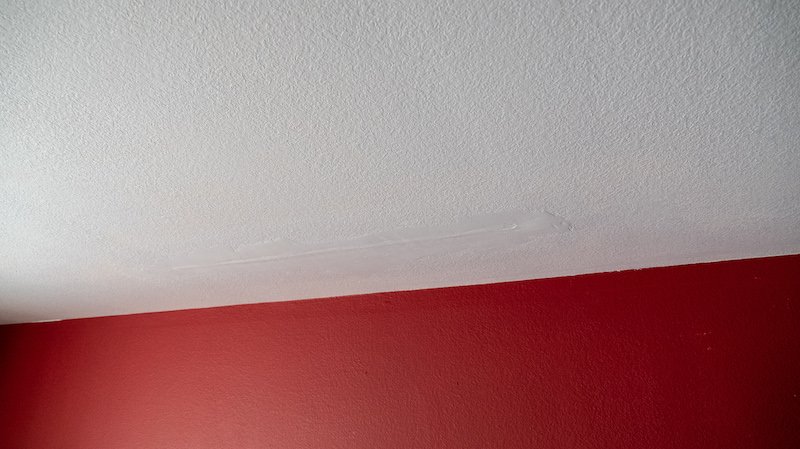
Other Building Material Damage
Water leaking into your attic, walls, and other hidden areas may also damage framing lumber, plywood sheathing, brick, insulation, siding, trim, cabinets, etc. Water tends to make things swell, and water based adhesives and glues may fail as well, causing gypsum and particle board to crumble, and plywood to delaminate (separate). Salt can leach from brick and cause white stains. Wet insulation loses its insulating properties and may not regain them when it dries. Fasteners such as nails will rust and no longer hold things together. Some of these things take a long time, and a lot of moisture. All the same, you may not see any of it if you don’t know what to look for. Here’s a photo of the inside of a wall that had years of water dripping in, from leaking flashing on the roof.
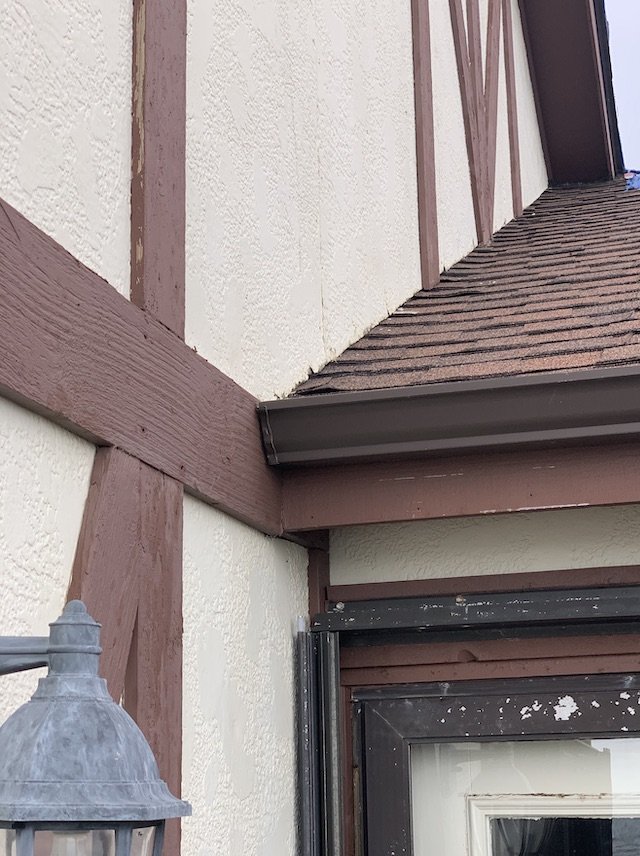
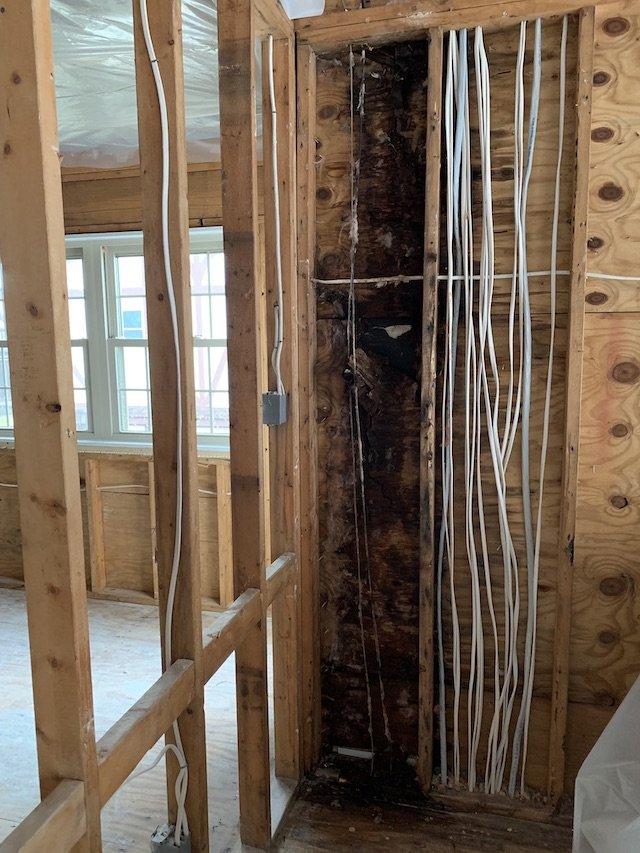
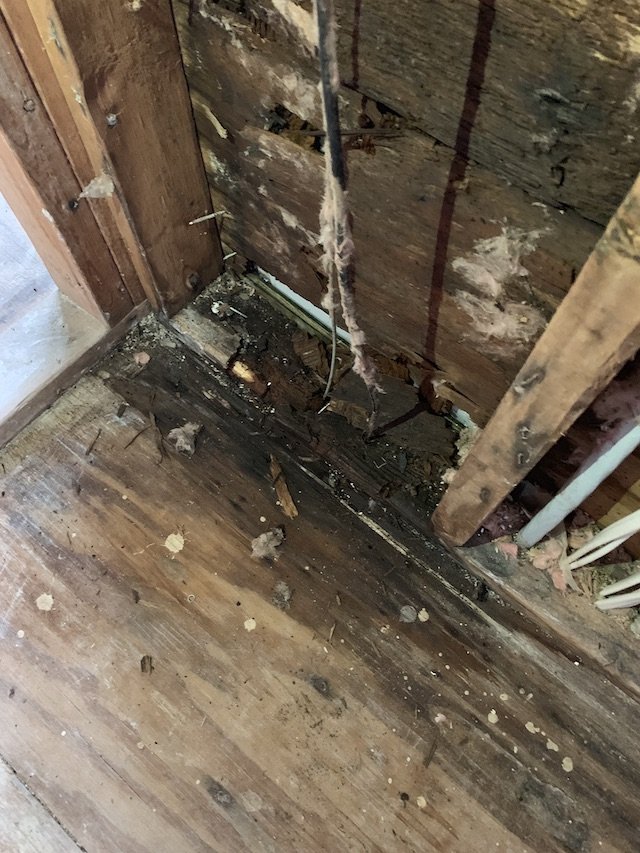
Roof Leak Repair Reviews: What Our Customers Say About Cook Roofing
To review, here are some things to look for if you think you might have a roof leak:
- Presence of Mold/Mildew/Moss
- Water Dripping From Ceiling
- Exterior or Interior Water Stains
- Waterlogged Attic Beams
- Outside Light From Roof
- Missing Flashing/Shingles
Contact Us For Roof Leak Repair
Cook Roofing Company has the availability, experience, and expertise to find, diagnose, and repair your roof leak in Springfield MO and Branson! If you have any questions, please call us at (417) 334-4238 today!

